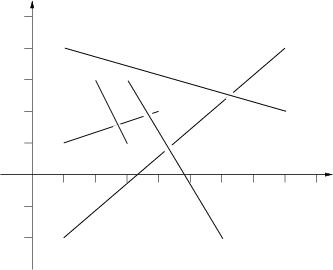poj2653Pick-up sticks【判断线段相交】
2015-09-03 23:39
239 查看
| Pick-up sticks
Stan has n sticks of various length. He throws them one at a time on the floor in a random way. After finishing throwing, Stan tries to find the top sticks, that is these sticks such that there is no stick on top of them. Stan has noticed that the last thrown stick is always on top but he wants to know all the sticks that are on top. Stan sticks are very, very thin such that their thickness can be neglected. Input Input consists of a number of cases. The data for each case start with 1 <= n <= 100000, the number of sticks for this case. The following n lines contain four numbers each, these numbers are the planar coordinates of the endpoints of one stick. The sticks are listed in the order in which Stan has thrown them. You may assume that there are no more than 1000 top sticks. The input is ended by the case with n=0. This case should not be processed. Output For each input case, print one line of output listing the top sticks in the format given in the sample. The top sticks should be listed in order in which they were thrown. The picture to the right below illustrates the first case from input.  Sample Input 5 1 1 4 2 2 3 3 1 1 -2.0 8 4 1 4 8 2 3 3 6 -2.0 3 0 0 1 1 1 0 2 1 2 0 3 1 0 Sample Output Top sticks: 2, 4, 5. Top sticks: 1, 2, 3. Hint Huge input,scanf is recommended. |
解题思路枚举判断线段相交即可
#include<cstdio>
#include<cstdlib>
#include<cstring>
#define eps 1e-8
using namespace std;
struct point{
double x,y;
};
struct line{
point a,b;
}A[100010];
double MAX(double a,double b){
return a>b?a:b;
}
double MIN(double a,double b){
return a<b?a:b;
}
bool judge(int a,int b){
if(MIN(A[a].a.x,A[a].b.x)>MAX(A[b].a.x,A[b].b.x)||MIN(A[a].a.y,A[a].b.y)>MAX(A[b].a.y,A[b].b.y)||MIN(A[b].a.x,A[b].b.x)>MAX(A[a].a.x,A[a].b.x)||MIN(A[b].a.y,A[b].b.y)>MAX(A[a].a.y,A[a].b.y))
return false;
double h,i,j,k;
h=(A[a].b.x-A[a].a.x)*(A[b].a.y-A[a].a.y)-(A[a].b.y-A[a].a.y)*(A[b].a.x-A[a].a.x);
i=(A[a].b.x-A[a].a.x)*(A[b].b.y-A[a].a.y)-(A[a].b.y-A[a].a.y)*(A[b].b.x-A[a].a.x);
j=(A[b].b.x-A[b].a.x)*(A[a].a.y-A[b].a.y)-(A[b].b.y-A[b].a.y)*(A[a].a.x-A[b].a.x);
k=(A[b].b.x-A[b].a.x)*(A[a].b.y-A[b].a.y)-(A[b].b.y-A[b].a.y)*(A[a].b.x-A[b].a.x);
return h*i<=eps&&j*k<=eps;
}
int main()
{
int i,j,k,n;
while(scanf("%d",&n),n){
for(i=1;i<=n;++i){
scanf("%lf%lf%lf%lf",&A[i].a.x,&A[i].a.y,&A[i].b.x,&A[i].b.y);
}
printf("Top sticks: ");
for(i=1;i<n;++i){
for(j=i+1;j<=n;++j){
if(judge(i,j)){
break;
}
}
if(j>n){
printf("%d, ",i);
}
}
printf("%d.\n",n);
}
return 0;
}相关文章推荐
- 南邮 OJ 1127 Stick
- ubuntu 12.04.4 安装nginx部署session sticky
- 特殊权限控制之SUID、SGID、Sticky及facl
- 特殊权限stick_bit
- Ionic2 Sticky 粘附效果
- linux的特殊权限(转载)
- centos 特殊权限stick用法
- JavaScript 动态脚本
- 《第一行代码》读书笔记(四)----碎片
- eclipse 十六进制查看变量
- eclipse使用前的设置
- Linux主机系统目录误操作权限修改为777修复方法
- c 字符转字符串
- JAVA I/0流
- Python核心概念之数据模型和执行模型
- clojure实战--midje测试框架
- polya定理
- 制作Redhat/CentOS/Fedora更新源
- 变长参数
- 离散化问题
